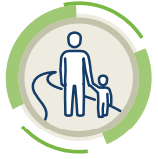Building connected comfortable and safe walking environments for all from 2019-2021

Action area: Building connected, comfortable and safe walking environments for all
2.1 Implement a program of pilot projects to support walking such as connected network plans, minor infrastructure, amenity, shade and encouragement programs. Evaluate outcomes and publish case studies.
Read Action 2.1 summary - Creating walkable environments
2.2 Invest $20 million over 4 years through the School Transport Infrastructure Program (STIP) to prioritise safe school travel, including active travel, through a variety of infrastructure solutions.
Read Action 2.2 summary - Prioritising Safe School Travel
2.3 Introduce Next Generation Traffic Signal Controller technology to provide a platform for exploring new ways of operating signals and new sensor technologies including to support active transport. Provide training in applying new technology.
2.4 Explore, as part of the state wide key regional corridor signal optimisation planning project, ways to reduce pedestrian wait times at pedestrian crossings located on key regional corridors, especially in areas of higher pedestrian demand.
Read Action 2.4 summary - Reducing pedestrian wait time at crossings
2.5 Support local governments through funding grants for bus stop facilities upgrades to improve accessibility of passenger transport services for everyone.
Read Action 2.5 summary - Improved walking access at bus stops
2.6 Implement lower speed limits in at least 20 locations over 2 years in high active transport (walking and bike riding) user areas. Publish case studies from demonstration projects at Cairns central business district and David Low Way at Coolum.
Read Action 2.6 summary - Creating liveable places
2.7 Provide information and training that supports local governments to implement lower speed limits in and around schools, public transport and busy pedestrian areas.
Read Action 2.7 summary - Making roads and precincts safer
2.8 Invest $4.5 million over 3 years in smart crossings to improve convenience, accessibility, comfort and safety of signalised crossings for pedestrians. Up to 300 crossings to be upgraded in the first 2 years, beginning in 2019-20. Provide support by developing guidelines to help local governments to implement smart crossings on their roads.
2.9 Incorporate best practice planning and design measures to improve pedestrian and bike rider safety and accessibility at rail level crossings, in consultation with key stakeholders.
Read Action 2.9 summary - Improving walking at rail level crossings
2.10 Deliver projects in accordance with the Road Safety Policy (TMR, 2018) including providing for pedestrians and people with disability. Publish case studies of good practice and review the policy every 3 years.
Read Action 2.10 summary - Applying policy to improve walking safety
Action area: Revitalising local economies
2.11 Investigate potential for ‘quicker, lighter, cheaper’ improvements and initiatives, including reallocating road space in high demand pedestrian areas, to revitalise local streets and places. Publish findings.
Read Action 2.11 summary - Lighter, quicker, cheaper
2.12 Identify opportunities to repurpose former highways and revitalise regional town centres for walking and bike riding when highway bypasses, ring roads and road realignments are being planned. Collaborate with partner organisations to seek funding for delivery.
Read Action 2.12 summary - Planning for places and movement
Action area: Further developing our walking tracks and trails
2.13 Deliver the Eco Tourism Trails Program across regions in Queensland in accordance with the Queensland Ecotourism Plan 2016–2020.
Read Action 2.13 summary - Creating iconic walking experiences
- Last updated 31 October 2023

